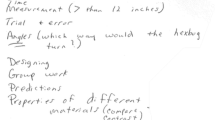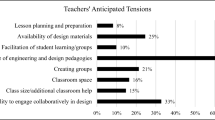Abstract
This qualitative study examines the influence of a 3-year professional development project for middle school mathematics, science, and special education teachers focused on integrating science, mathematics, and engineering in classroom instruction on participants’ understandings of productive struggle in learning. Multi-disciplinary teams of teachers engaged as learners to use engineering design as a framework for integrating significant mathematics and science content supported by effective teaching practices. In this paper, we describe how the components of our professional development design supported teacher-participants to make sense of productive struggle in learning. In particular, participants noted that being able to experience design-based activities as learners and working through solutions with their colleagues supported their understanding of what it means to productively struggle, resulting in their growth as individuals and as teachers. The significance in this work lies in understanding how to effectively support teachers to buy-in to the meaning and value of productive struggle and how engaging in integrated science, technology, engineering, and mathematics (STEM), design-based professional learning experiences facilitated that effort.
Résumé
Cette étude qualitative se penche sur l’influence qu’a eue un projet de formation professionnelle d’une durée de trois ans, destiné aux enseignants de mathématiques, de sciences et d’éducation spécialisée de l’école intermédiaire et axé sur l’intégration des sciences, des mathématiques et de l’ingénierie dans l’enseignement en classe, sur la compréhension qu’ont les participants de la « difficulté productive» dans l’apprentissage. Des équipes multidisciplinaires d’enseignants, appuyées par des pratiques d’enseignement efficaces se sont engagées, en tant qu’apprenants, à utiliser la conception technique comme cadre d’intégration de contenus mathématiques et scientifiques importants. Dans cet article, nous décrivons comment les éléments formant notre concept de formation professionnelle ont aidé les enseignants participants à donner un sens à la « difficulté productive» dans le processus d’apprentissage. En particulier, les participants ont remarqué que le fait de pouvoir expérimenter des activités fondées sur la conception en tant qu’apprenants et de travailler à trouver des solutions avec leurs collègues les a aidés à comprendre ce que signifie la « difficulté productive», ce qui a contribué à leur croissance en tant qu’individus et en tant qu’enseignants. Ce qui ressort de ce travail, c’est l’importance de comprendre comment aider efficacement les enseignants à adhérer au sens donné à la « difficulté productive» ainsi qu’à son bien-fondé, et comment l’engagement dans des expériences d’apprentissage professionnel intégrées et fondées sur la conception en sciences, en technologie, en ingénierie et en mathématiques (STIM) a facilité cet effort.

Source: Curtis et al. (2023). Reprinted with permission from Teachers College Press via fair use guidelines. Created with Microsoft Word
Similar content being viewed by others
References
Baker, K., Jessup, N. A., Jacobs, V. R., Empson, S. B., & Case, J. (2020). Productive struggle inaction. Mathematics Teacher: Learning & Teaching PK-12, 113(5), 361-374
Barkatsas, A. T., & Malone, J. (2005). A typology of mathematics teachers’ beliefs about teaching and learning mathematics and instructional practices. Mathematics Education Research Journal, 17, 69–90.
Borko, H. (2004). Professional development and teacher learning: Mapping the terrain. Educational Researcher, 33(8), 3–15. https://doi.org/10.3102/0013189X03300800.
Brown, R. E., Bogiages, C. A. (2019). Professional development through STEM integration: How early career math and science teachers respond to experiencing integrated STEM tasks. International Journal of Science and Mathematics Education, 17, 111-128. https://doi.org/10.1007/s10763-017-9863-x
Brown, J. S., Collins, A., & Duguid, P. (1989). Situation cognition and the culture of learning. Educational Researcher, 18(1), 32-42.
Brown, T. & Wyatt, J. (2010). Design thinking for social innovation. Stanford Social Innovation Review, 8(1), 30-35.
Bush, S. B., Karp, K. S., Cox, R., Cook, K. L., Albanese, J., & Karp, M. (2018). Design thinking framework: shaping powerful mathematics. Mathematics Teaching in the Middle School, e1-e5.
Cirillo, M., Pelesko, J. A., Felto-Kestler, M. D., & Rubel, L. (2016). Perspectives on modeling in school mathematics, pp. In C. R. Hirsch, & A. R. McDuffie, (Eds.) Annual perspectives in mathematics education: Mathematical modeling and modeling mathematics (3-16). National Council of Teachers of Mathematics.
Collins, A., Brown, J. S., & Newman, S. E. (1989). Cognitive apprenticeship: Teaching the crafts of reading, writing, and mathematics. In L. B. Resnick (Ed.), Knowing, learning, and instruction: Essays in honor of Robert Glasser (pp. 453-494). Routledge.
Collins, A., & Kapur, M. (2014). Cognitive apprenticeship. In R. Sawyer (Ed.), The Cambridge handbook of the learning sciences (Cambridge Handbooks in Psychology, pp. 109–127). Cambridge University Press. https://doi.org/10.1017/CBO9781139519526.008
Cooper, R., Fitzgerald, A., & Carpendale, J. (2022). A reading group for science educators: An approach for developing collective pedagogical content knowledge in science education. International Journal of Science and Mathematics Education. https://doi.org/10.1007/s10763-022-10260-y
Curtis, R., Cairns, D. R., & Bolyard, J. (2023). Design thinking in the middle grades: Transforming mathematics and science learning. NY: Teachers College.
Czerniak, C. (2007). Interdisciplinary science teaching. In S. Abell & N. Lederman (Eds.), Handbook of research on science education, 537–559. New York: Routledge.
Drake, C. (2006). Turning points: Using teachers’ mathematics life stories to understand the implementation of mathematics education reform. Journal of Mathematics Teacher Education, 9(6), 579–608.
Dym, C. L., Agogino, A. M., Eris, O., Frey, D. D., & Leifer, L. J. (2005). Engineering design thinking, teaching, and learning. Journal of Engineering Education, 94(1), 103-120. https://doi.org/10.1002/j.2168-9830.2005.tb00832
Engle, R. A. (2006). Framing interactions to foster generative: A situation explanation of transfer in a community of learners classroom. Journal of the Learning Sciences, 15(4), 451–498.
Fennema, E., Peterson, P. L., Carpenter, T. P., & Lubinski, C. A. (1990). Teachers’ attributions and beliefs about girls, boys, and mathematics. Educational Studies in Mathematics, 21(1), 55–69.
Forzani, F. M. (2014). Understanding “core practices” and “practice-based” teacher education: Learning from the past. Journal of Teacher Education, 65, 357–368.
Franke, M. L., Turrou, A. C., Webb, N. M., Ing, M., Wong, J., Shin, N., & Fernandez, C. (2015). Student engagement with others’ mathematical ideas: The role of teacher invitation and support moves. Elementary School Journal, 116(1), 126–148.
Goldsmith, L. T., Doerr, H. M., & Lewis, C. C. (2014). Mathematics teachers’ learning: A conceptual framework and synthesis of research. Journal of Mathematics Teacher Education, 17, 5-36. https://doi.org/10.1007/s10857-013-9245-4
Gresfali, M., Martin, T., Hand, V., & Greeno, J. (2009). Constructing competence: An analysis of student participation in the activity systems of mathematics classrooms. Educational Studies in Mathematics, 70(1), 49–70.
Hafiz, R. M., & Ayop, S. K. (2019). Engineering design process in STEM education: A systematics review. International Journal of Academic Research in Business & Social Sciences, 9(5), 676-679.
Hiebert, J., & Grouws, D. A. (2007). The effects of classroom mathematics teaching on students’ learning. In F. K. Lester (Ed.), Second handbook of research on mathematics teaching and learning (pp. 371–404). Greenwich, CT: Information Age Publishing.
Huinker, D., & Bill, V. (2017). Taking action: Implementing effective mathematics teaching practices, K-grade 5. Reston, VA: NCTM.
Kapur, M. (2008). Productive failure. Cognition and Instruction, 26(3), 379–424.
Kapur, M. (2010). Productive failure in mathematical problem solving. Instructional Science, 38(6), 523–550.
Kapur, M. (2011). A further study of productive failure in mathematical problem solving: Unpacking the design components. Instructional Science, 39(4), 561–579.
Kapur, M., & Bielaczyc, K. (2012). Designing for productive failure. Journal of the Learning Sciences, 21(1), 45–83.
Kelley, D. & Kelley, T. (2013) Creative confidence: Unleashing the creative potential within us all. New York, NY: Crown Business.
Lieberman, A., & Mace, D. H. P. (2008). Teacher learning: The key to educational reform. Journal of Teacher Education, 59(3), 226-234. https://doi.org/10.1177/0022487108317020
Lotan, R. (2003). Group-worthy tasks. Educational Leadership, 60(6), 72-75.
Louie, N. L. (2017). The culture of exclusion in mathematics education and its persistence in equity-oriented teaching. Journal for Research in Mathematics Education, 48(5), 488-519.
McDonald, M., Kazemi, E., & Kavanaugh, S. S. (2013). Core practices and pedagogies of teacher education: A call for a common language and collective activity. Journal of Teacher Education, 64, 378–386.
National Council of Teachers of Mathematics (NCTM). (2014). Principles to actions: Ensuring mathematical success for all. National Council of Teachers of Mathematics.
NGA & CCSSO, N. G. A. C. for B. P. and C. of C. S. S. O. (2010). Common core standards for mathematics. Retrieved from http://www.corestandards.org
NGSS Lead States. (2013). Next Generation Science Standards: For states, by states. National Academies Press. Retrieved from https://www.nextgenscience.org/
Opfer, V. D., & Pedder, D. (2011). Conceptualizing teacher professional learning. Review of Educational Research, 81(3), 376-407. https://doi.org/10.3102/0034654311413609
Patton, M. Q. (2014). Qualitative research & evaluation methods: Integrating theory and practice (4th ed.). Sage.
Piaget, J. (1960). The general problems of the psycho-biological development of the child. In Discussions on child development (Vol. 4, pp. 3–27). London: Tavistock.
Rojas, L., & Liou, D. D. (2017). Social justice teaching through the sympathetic touch of caring and high expectations for students of color. Journal of Teacher Education, 68(1), 28–40. https://doi.org/10.1177/0022487116676314
Saldaña, J. (2013). The coding manual for qualitative researchers (2nd ed.). Thousand Oaks, CA: Sage Publications, Inc.
Schwartz, D. L., & Martin, T. (2004). Inventing to prepare for future learning: The hidden efficiency of encouraging original student production in statistics instruction. Cognition and Instruction, 22, 129–184.
Skemp, R. R. (1971). The psychology of learning mathematics. Harmondsworth, UK: Penguin.
Stein, M. K., Smith, M. S., Henningsen, M. A., & Silver, E. A. (2009). Implementing standards-based mathematics instruction: A casebook for professional development (2nd ed.). Reston, VA: National Council of Teachers of Mathematics.
Stigler, J. W., & Hiebert, J. (2004). The teaching gap: Best ideas from the world’s teachers for improving education in the classroom. New York: Free Press.
Tools for ambitious science teaching. (n.d.). Retrieved from http://ambitiousscienceteaching.org/us/
Townsend, C., Slavit, D., & McDuffie, A. R. (2018). Supporting all learners in productive struggle. Mathematics Teaching in the Middle School, 216–224. https://doi.org/10.5951/mathteacmiddscho.23.4.00e1
Valentine, K., & Bolyard, J. (2018, April 13-17). Creating a Classroom Culture that Supports Productive Struggle: Pre-service Teachers’ Reflections on Teaching Mathematics [Paper presentation]. American Educational Research Association, New York, NY, United States.
Vygotsky, L. S. (1978). Mind in society: The development of higher psychological processes. Cambridge, MA: Harvard University Press.
Warshauer, H. K. (2015). Productive struggle in middle school mathematics classrooms. Journal of Mathematics Teacher Education, 18(4), 375–400.
Acknowledgements
This work was supported by the West Virginia Department of Education and the Regional Education Support Agency (RESA) 3.
Author information
Authors and Affiliations
Corresponding author
Ethics declarations
Ethics Approval and Consent to Participate
The datasets generated and analyzed during the current study are not publicly available due to protection or privacy of the participants.
Competing Interests
The authors declare no competing interests.
Additional information
Publisher's Note
Springer Nature remains neutral with regard to jurisdictional claims in published maps and institutional affiliations.
Rights and permissions
Springer Nature or its licensor (e.g. a society or other partner) holds exclusive rights to this article under a publishing agreement with the author(s) or other rightsholder(s); author self-archiving of the accepted manuscript version of this article is solely governed by the terms of such publishing agreement and applicable law.
About this article
Cite this article
Bolyard, J., Curtis, R. & Cairns, D. Learning to Struggle: Supporting Middle-grade Teachers’ Understanding of Productive Struggle in STEM Teaching and Learning. Can. J. Sci. Math. Techn. Educ. 23, 687–702 (2023). https://doi.org/10.1007/s42330-023-00302-0
Accepted:
Published:
Issue Date:
DOI: https://doi.org/10.1007/s42330-023-00302-0




